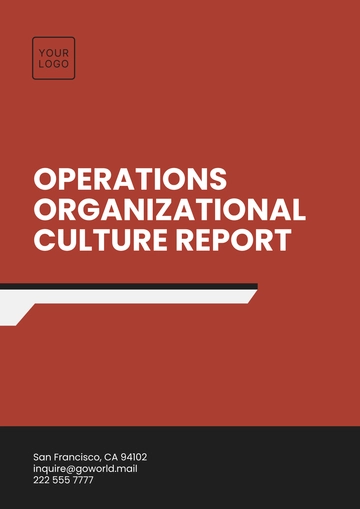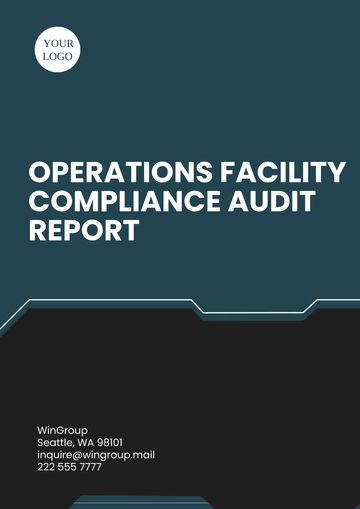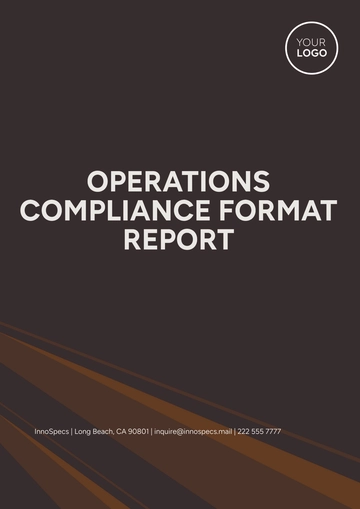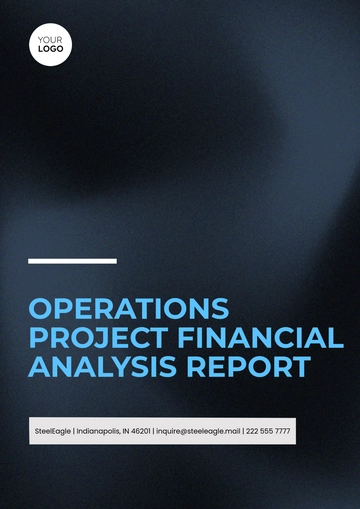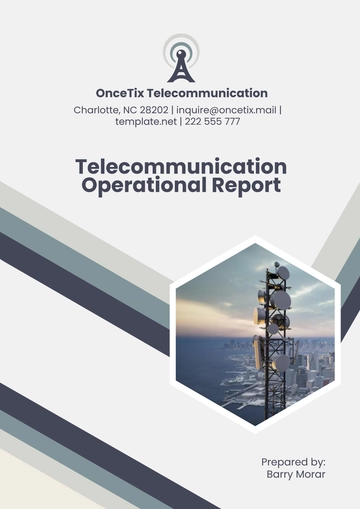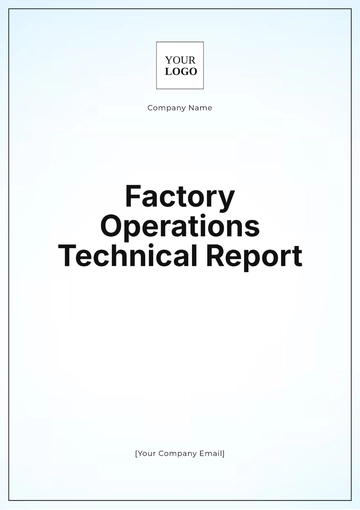Free Operations Organizational Culture Report

[Your Company Name]
[Your Company Email]
I. Introduction
This report delves into the various dimensions of organizational culture within the context of operations management of [Your Company Name]. By examining methodology, cultural dimensions, strengths, weaknesses, alignment with goals, employee perceptions, leadership influence, and recommendations, this report aims to provide insights into optimizing organizational culture for operational effectiveness.
II. Methodology
The methodology employed for this report involved a comprehensive analysis of existing literature on organizational culture and operations management of [Your Company Name]. Additionally, qualitative data was gathered through interviews and surveys with employees across different levels of the organization. This multi-faceted approach enabled a holistic understanding of the interplay between culture and operations within the company.
A. Literature Review
A thorough review of academic and industry literature was conducted to explore the theoretical frameworks and empirical research related to organizational culture and its impact on operations management. Key concepts, models, and theories were synthesized to inform the analysis and interpretation of findings.
B. Interviews
Semi-structured interviews were conducted with key stakeholders, including senior management, department heads, and frontline employees, to gather qualitative insights into the organization's culture and its implications for operations. Interview questions were designed to probe specific aspects of culture, such as communication norms, decision-making processes, and leadership styles.
C. Surveys
Quantitative data was collected through surveys distributed to a representative sample of employees across various departments and locations. The survey instrument was designed to measure perceptions of organizational culture, including dimensions such as teamwork, innovation, and job satisfaction. Likert-scale questions and open-ended prompts were utilized to capture both quantitative and qualitative feedback.
D. Data Analysis
Data from interviews and surveys were analyzed using both qualitative and quantitative methods. Qualitative data were coded and thematically analyzed to identify recurring patterns, themes, and insights. Quantitative data were analyzed using statistical software to calculate descriptive statistics, correlation coefficients, and other relevant metrics.
E. Triangulation
The findings from different data sources were triangulated to validate and corroborate key insights. Triangulation helped mitigate bias and enhance the reliability and validity of the findings, providing a more robust understanding of the relationship between organizational culture and operations.
III. Understanding Cultural Dimensions
A. Power Distance
Power distance refers to the extent to which less powerful members of an organization accept and expect unequal distribution of power. In the context of operations, a high power distance culture may result in centralized decision-making and a hierarchical structure, where authority is concentrated at the top. Conversely, a low power distance culture promotes decentralized decision-making and encourages collaboration among team members, fostering a more egalitarian work environment.
B. Individualism vs. Collectivism
Individualism vs. collectivism pertains to the degree to which individuals prioritize personal goals and autonomy over group cohesion and collective interests. In operations, a culture that leans towards individualism may value independent problem-solving and self-reliance, while a collectivist culture emphasizes teamwork, collaboration, and shared responsibility. Understanding this dimension helps in shaping communication strategies and decision-making processes within the operations function.
C. Masculinity vs. Femininity
Masculinity vs. femininity describes the distribution of values within a society regarding assertiveness, ambition, and competitiveness (masculine) versus nurturing, cooperation, and quality of life (feminine). In operations management, a masculine culture may prioritize achievement, performance, and goal-oriented behaviors, while a feminine culture may emphasize work-life balance, employee well-being, and relationship-building. Balancing these values is essential for creating a supportive and sustainable work environment.
D. Uncertainty Avoidance
Uncertainty avoidance reflects the extent to which individuals within a society are comfortable with ambiguity, uncertainty, and risk. In operations, a high uncertainty avoidance culture may manifest in rigid procedures, strict adherence to rules, and aversion to change, whereas a low uncertainty avoidance culture encourages innovation, adaptability, and experimentation. Managing uncertainty effectively is critical for driving agility and resilience in operations.
E. Long-term vs. Short-term Orientation
Long-term vs. short-term orientation focuses on the time horizon of decision-making and planning within a culture. In operations management, a long-term orientation emphasizes patience, persistence, and investment in future outcomes, while a short-term orientation prioritizes immediate results and efficiency. Balancing short-term goals with long-term sustainability is essential for achieving operational excellence and organizational resilience.
Understanding these cultural dimensions provides valuable insights into the underlying values, norms, and behaviors that shape organizational culture within the operations function. By recognizing and leveraging cultural strengths while addressing potential areas of misalignment, organizations can cultivate a culture that fosters collaboration, innovation, and operational effectiveness.
IV. Strengths
[Your Company Name] exhibits several strengths in its operational culture, which contribute to its overall effectiveness and success. These strengths include:
Emphasis on Teamwork and Collaboration: The culture promotes a collaborative work environment where employees are encouraged to work together towards common goals. Teamwork is valued and rewarded, fostering strong bonds among team members and enhancing productivity.
Commitment to Continuous Improvement and Innovation: There is a culture of continuous improvement and innovation, where employees are empowered to identify areas for enhancement and implement creative solutions. This commitment to innovation enables the organization to stay ahead of competitors and adapt to changing market conditions.
Customer-Centric Approach: The organization prioritizes customer satisfaction and strives to exceed customer expectations in all aspects of its operations. Employees are empowered to deliver exceptional service and address customer needs promptly, enhancing customer loyalty and retention.
Open Communication and Transparency: There is a culture of open communication and transparency, where employees feel comfortable sharing ideas, concerns, and feedback. Management actively solicits input from employees and provides regular updates on company performance, fostering trust and engagement.
Shared Sense of Purpose: Employees are aligned with the company's mission, vision, and values, creating a shared sense of purpose and commitment to success. This shared sense of purpose motivates employees to go above and beyond in their roles and contributes to a positive and supportive work culture.
V. Weaknesses
While [Your Company Name] boasts several strengths in its operational culture, it also faces certain weaknesses that warrant attention and remediation. These weaknesses include:
Tendency Towards Bureaucracy and Hierarchy: The organization may exhibit bureaucratic tendencies and a hierarchical structure that stifles agility and innovation. Decision-making processes may be slow and centralized, hindering responsiveness to market changes and customer needs.
Resistance to Change: Certain segments of the organization may demonstrate resistance to change, particularly in adopting new technologies or processes. This resistance to change can impede innovation and hinder the organization's ability to adapt to evolving business environments.
Lack of Diversity and Inclusion Initiatives: The organization may lack robust diversity and inclusion initiatives, resulting in a homogeneous workforce and limited perspectives. A lack of diversity can lead to groupthink and inhibit creativity and innovation within the organization.
Communication Challenges: Communication channels within the organization may be ineffective or inefficient, leading to misunderstandings, silos, and barriers to collaboration. Poor communication can result in delays, errors, and missed opportunities for improvement.
Limited Opportunities for Growth and Development: Employees may perceive limited opportunities for growth and development within the organization, leading to dissatisfaction and turnover. A lack of clear career paths and professional development opportunities can demotivate employees and impact retention.
Addressing these weaknesses is essential for fostering a more agile, inclusive, and innovative operational culture within the organization. By acknowledging and proactively addressing these areas for improvement, the organization can strengthen its competitive position and enhance its ability to achieve strategic objectives.
VI. Cultural Alignment with Goals
[Your Company Name]’s culture demonstrates a strong alignment with goals related to innovation and agility. Cultural norms that encourage experimentation, risk-taking, and adaptability are conducive to fostering innovation and responding effectively to market changes. Employees feel empowered to propose new ideas, challenge the status quo, and embrace change, which aligns with the organization's goals of staying ahead of competitors and driving continuous improvement.
A. Innovation and Agility
The organization's culture demonstrates a strong alignment with goals related to innovation and agility. Cultural norms that encourage experimentation, risk-taking, and adaptability are conducive to fostering innovation and responding effectively to market changes. Employees feel empowered to propose new ideas, challenge the status quo, and embrace change, which aligns with the organization's goals of staying ahead of competitors and driving continuous improvement.
B. Customer Satisfaction and Quality
Cultural values emphasizing customer focus, quality, and excellence are closely aligned with the organization's goals of delivering exceptional products or services and exceeding customer expectations. Employees prioritize customer satisfaction in their daily activities, seeking to understand customer needs and preferences and delivering high-quality solutions. This alignment contributes to the organization's reputation for reliability, trustworthiness, and customer loyalty.
C. Operational Efficiency and Effectiveness
The organization's culture exhibits a commitment to operational excellence and efficiency, aligning closely with goals related to productivity, cost-effectiveness, and resource optimization. Cultural norms that promote teamwork, collaboration, and accountability enable employees to streamline processes, eliminate waste, and achieve operational targets effectively. This alignment enhances the organization's competitiveness and ensures its ability to deliver value to stakeholders.
D. Employee Engagement and Satisfaction
Cultural practices that prioritize employee well-being, engagement, and satisfaction are aligned with the organization's goals of attracting, retaining, and developing top talent. Employees feel valued, supported, and motivated to perform at their best, leading to higher levels of productivity, creativity, and commitment. This alignment contributes to a positive workplace culture and enhances the organization's reputation as an employer of choice.
E. Financial Performance and Growth
The organization's culture plays a significant role in driving financial performance and growth, aligning with goals related to revenue generation, profitability, and market expansion. Cultural norms that promote accountability, performance-driven behaviors, and a focus on results contribute to achieving financial targets and sustaining long-term growth. This alignment strengthens the organization's position in the market and ensures its ability to create value for shareholders and investors.
F. Sustainability and Corporate Social Responsibility
Cultural values that emphasize sustainability, ethical conduct, and corporate social responsibility are aligned with the organization's goals of contributing positively to society and minimizing its environmental footprint. Employees are committed to ethical business practices, environmental stewardship, and community engagement, reflecting the organization's broader mission and values. This alignment enhances the organization's reputation, mitigates risks, and creates long-term value for stakeholders.
VII. Employee Perceptions
Employee perceptions play a significant role in shaping organizational culture and can provide valuable insights into the effectiveness of operations within the company. Through surveys and interviews, a diverse range of employee perceptions were gathered, offering a comprehensive understanding of the organizational culture from the ground level. The following key themes emerged from the analysis of employee perceptions:
A. Sense of Pride and Belonging
Employees expressed a strong sense of pride and belonging within the organization, citing factors such as the company's mission, values, and positive work environment. Many employees emphasized feeling valued and appreciated for their contributions, which contributed to a sense of loyalty and commitment to the organization's success.
B. Opportunities for Growth and Development
While some employees expressed satisfaction with the opportunities for growth and development within the organization, others identified areas for improvement. Specifically, concerns were raised regarding the clarity of career paths, access to training and development programs, and opportunities for advancement. Addressing these concerns is crucial for retaining top talent and fostering a culture of continuous learning and professional development.
C. Communication and Feedback
Communication emerged as a recurring theme in employee perceptions, with both positive and negative feedback provided. While some employees praised the organization for its transparent communication channels and receptiveness to feedback, others identified areas for improvement. Common concerns included inconsistent communication, limited opportunities for upward feedback, and a lack of clarity regarding organizational decisions.
D. Work-Life Balance
Employees highlighted the importance of work-life balance and expressed varying levels of satisfaction with their ability to achieve this balance within the organization. While some employees praised the organization for its flexibility and support in managing work-life commitments, others identified challenges such as long hours, high workload, and limited flexibility in scheduling.
E. Recognition and Rewards
Recognition and rewards emerged as important factors influencing employee morale and motivation. Many employees expressed appreciation for the recognition they received for their contributions, whether through formal reward programs or informal acknowledgments. However, concerns were raised regarding the consistency and fairness of reward systems, with some employees feeling undervalued or overlooked.
F. Leadership and Management
Employee perceptions of leadership and management varied, with both positive and negative feedback provided. While some employees praised the organization's leadership for their vision, support, and communication skills, others identified areas for improvement. Common concerns included inconsistency in leadership styles, lack of transparency in decision-making, and perceived favoritism or bias.
G. Organizational Values and Culture
Overall, employees expressed alignment with the organization's values and culture, citing factors such as teamwork, innovation, and customer focus. Many employees identified these values as key drivers of their engagement and commitment to the organization. However, concerns were raised regarding the consistency of cultural practices across different departments or teams, highlighting the importance of fostering a cohesive and inclusive organizational culture.
Understanding these employee perceptions is essential for identifying areas of strength and areas for improvement within the organizational culture. By addressing employee concerns and building on existing strengths, the organization can enhance employee engagement, satisfaction, and overall operational effectiveness.
VIII. Leadership Influence
Leadership plays a pivotal role in shaping the culture of [Your Company Name] and driving operational performance. Through a comprehensive examination of leadership practices and their impact on culture, the following observations were made:
A. Vision and Direction
Effective leadership provides a clear vision and direction for the organization, aligning the efforts of employees with strategic goals and objectives. Leaders communicate a compelling vision for the future, inspiring employees to rally behind common goals and aspirations. By setting a clear direction and articulating the organization's purpose, leaders establish a sense of purpose and direction that guides decision-making and actions at all levels of the organization.
B. Support and Empowerment
Leadership influence is evident in the level of support and empowerment provided to employees. Effective leaders create a supportive work environment where employees feel valued, respected, and empowered to take ownership of their work and contribute to the organization's success. By fostering a culture of trust, autonomy, and empowerment, leaders enable employees to unleash their full potential and drive innovation, creativity, and productivity.
C. Communication and Transparency
Communication is a hallmark of effective leadership, facilitating alignment, collaboration, and engagement within the organization. Leaders communicate openly and transparently, sharing information, updates, and feedback with employees regularly. By fostering a culture of open communication, leaders build trust, foster collaboration, and promote a shared understanding of organizational goals and priorities.
D. Accountability and Performance Management
Leadership influence extends to accountability and performance management practices within the organization. Effective leaders hold themselves and others accountable for achieving results, setting high performance standards, and providing regular feedback and coaching to support employee growth and development. By instilling a culture of accountability, leaders drive excellence, foster continuous improvement, and ensure the organization's success.
E. Diversity and Inclusion
Leadership sets the tone for diversity and inclusion within the organization, shaping the culture and ensuring that all voices are heard and valued. Effective leaders champion diversity and inclusion initiatives, fostering a culture of belonging where employees from diverse backgrounds feel welcome, respected, and empowered to contribute their unique perspectives and talents. By promoting diversity and inclusion, leaders enhance innovation, creativity, and organizational performance.
F. Adaptability and Change Management
Leadership influence is particularly crucial during times of change and uncertainty. Effective leaders embrace change as an opportunity for growth and innovation, guiding the organization through transitions with confidence and resilience. By fostering a culture of adaptability and resilience, leaders empower employees to embrace change, overcome challenges, and seize opportunities for growth and improvement.
G. Role Modeling and Integrity
Leadership influence is exemplified through role modeling and integrity, as leaders serve as role models for organizational values and behaviors. Effective leaders demonstrate integrity, honesty, and ethical conduct in all their interactions, inspiring trust and confidence among employees. By embodying the organization's values and leading by example, leaders set the tone for a positive and ethical organizational culture.
IX. Recommendations
Based on the findings of this report, the following recommendations are proposed to enhance the organizational culture within the operations function:
Diversity and Inclusion: Implement programs like bias training and ERGs to foster an inclusive workplace.
Communication: Enhance transparency with town halls and digital platforms.
Leadership Development: Train leaders in skills like communication and diversity.
Work-Life Balance: Support well-being with flexible work and stress management.
Performance Management: Align goals with incentives and provide feedback.
Cross-functional collaboration: Encourage teamwork and knowledge sharing.
Innovation: Create channels for idea submission and prototype support.
Employee Recognition: Implement recognition programs to boost morale.
Training and Development: Offer opportunities for employee skill growth.
Strategy Evaluation: Regularly assess and adjust initiatives for alignment.
X. Conclusion
In conclusion, organizational culture plays a critical role in shaping the success of operations within the company. By understanding cultural dimensions, strengths, weaknesses, alignment with goals, employee perceptions, and leadership influence, organizations can identify areas for improvement and implement targeted interventions to enhance operational effectiveness. Cultivating a culture that fosters collaboration, innovation, and continuous improvement is essential for driving sustainable growth and competitive advantage in today's dynamic business environment.
- 100% Customizable, free editor
- Access 1 Million+ Templates, photo’s & graphics
- Download or share as a template
- Click and replace photos, graphics, text, backgrounds
- Resize, crop, AI write & more
- Access advanced editor
Assess organizational culture with this Operations Organizational Culture Report Template, exclusively available at Template.net. This editable and customizable report template, available on Template.net alongside our AI Editor Tool, provides a structured framework to assess cultural attributes, identify strengths and areas for improvement, and recommend strategies to foster a positive and cohesive organizational culture.
You may also like
- Sales Report
- Daily Report
- Project Report
- Business Report
- Weekly Report
- Incident Report
- Annual Report
- Report Layout
- Report Design
- Progress Report
- Marketing Report
- Company Report
- Monthly Report
- Audit Report
- Status Report
- School Report
- Reports Hr
- Management Report
- Project Status Report
- Handover Report
- Health And Safety Report
- Restaurant Report
- Construction Report
- Research Report
- Evaluation Report
- Investigation Report
- Employee Report
- Advertising Report
- Weekly Status Report
- Project Management Report
- Finance Report
- Service Report
- Technical Report
- Meeting Report
- Quarterly Report
- Inspection Report
- Medical Report
- Test Report
- Summary Report
- Inventory Report
- Valuation Report
- Operations Report
- Payroll Report
- Training Report
- Job Report
- Case Report
- Performance Report
- Board Report
- Internal Audit Report
- Student Report
- Monthly Management Report
- Small Business Report
- Accident Report
- Call Center Report
- Activity Report
- IT and Software Report
- Internship Report
- Visit Report
- Product Report
- Book Report
- Property Report
- Recruitment Report
- University Report
- Event Report
- SEO Report
- Conference Report
- Narrative Report
- Nursing Home Report
- Preschool Report
- Call Report
- Customer Report
- Employee Incident Report
- Accomplishment Report
- Social Media Report
- Work From Home Report
- Security Report
- Damage Report
- Quality Report
- Internal Report
- Nurse Report
- Real Estate Report
- Hotel Report
- Equipment Report
- Credit Report
- Field Report
- Non Profit Report
- Maintenance Report
- News Report
- Survey Report
- Executive Report
- Law Firm Report
- Advertising Agency Report
- Interior Design Report
- Travel Agency Report
- Stock Report
- Salon Report
- Bug Report
- Workplace Report
- Action Report
- Investor Report
- Cleaning Services Report
- Consulting Report
- Freelancer Report
- Site Visit Report
- Trip Report
- Classroom Observation Report
- Vehicle Report
- Final Report
- Software Report


